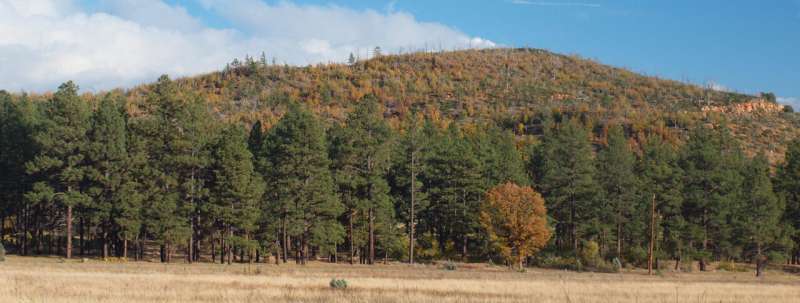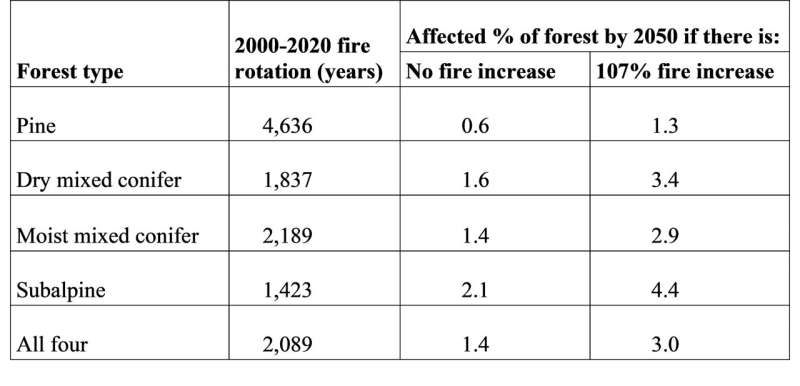November 1, 2023 dialog
This article has been reviewed according to Science X's editorial process and policies. Editors have highlighted the following attributes while ensuring the content's credibility:
fact-checked
trusted source
written by researcher(s)
proofread
Tree-regeneration decline and type-conversion after high-severity fires likely to cause little forest loss

Are western U.S. forests threatened so much by failing post-fire tree regeneration that extensive forest loss may occur by mid-century? Increasing temperatures are drying forests, more fires are being ignited, and they are increasingly burning at high severity, killing 70% or more of trees. High-severity fires leave behind post-fire openings that climate change is making hotter and drier; these spaces are often dominated by competitive shrubs and have substantial area that is distant from surviving trees that provide essential seed for tree regeneration.
Most conifers that dominate western U.S. forests rely on regeneration from seed, which typically reaches 100–200 m (328–656 feet) from surviving trees. This leaves more distant burned "interior" areas vulnerable to tree-regeneration decline and even type changes from forests to shrublands or grasslands, a global-change syndrome that could lead to more permanent forest loss.
Tree-regeneration decline and type conversion have been reported across major forest types from the lowest elevations up to near treeline and across the western U.S. However, the rates at which this syndrome is occurring depend on rates of the key triggers, high-severity fires, which are insufficiently known.
In a new study published in Climate, I measured rates and patterns of creation of vulnerable interiors of high-severity fires across four forest types covering about 80% (56 million ha or 138 million acres) of western U.S. forests. The four types include ponderosa pine (Pinus ponderosa) forests, dry mixed-conifer forests that have ponderosa mixed with other trees, moist mixed-conifer forests that are similar but have little ponderosa pine, and the highest elevation forests in the subalpine zone. A 21-year study period, 2000–2020, was used, as it was found to be the longest, most recent period lacking an upward trend in area burned at high severity in these forests.
I downloaded annual government maps of fires and their severities and used a geographical information system (GIS) to extract their interior high-severity areas >90 m (295 feet) inward from the outer edge of high severity. Since most conifers can disperse seed 100–200 m, this is a high estimate likely to include most of the vulnerable interior area.
I characterized rates of high-severity fires using the fire rotation, the expected period to burn one time across a land area equal to a study area of interest. This is estimated by first adding up the annual areas of fires over the 21 years, then extrapolating from the fraction of the total area of interest burned during this period. For example, if 20% of the land area of interest burned in 21 years, then the expected fire rotation is 21 years/0.20 or 105 years.
This fire rotation can then be used to estimate what fraction of land area is expected to burn by a certain year, for example, by 2050. Since 2050 is 27 years from 2023, which is 25.7% of the 105-year fire rotation, the expectation is 25.7% of the land area will have burned by 2050. Fire rotations of 105 years or less are concerning, since 25.7% would be a fairly large percentage of forest area affected by tree-regeneration decline and type-conversion by 2050.
However, fire rotations for vulnerable interior areas were very long from 2000 to 2020—between 1,423 and 4,636 years—which leads to an expectation of only about 0.6% to 2.1% of forest area being affected by 2050 if fires do not increase (see Table 1 below). This contrasts with the estimate that up to about 50% of forests could be affected by this syndrome by 2100, which would be about 18.5% by 2050.
I found that the vulnerable interior area had a very long fire rotation because high-severity fires were complex in shape and not large, having much of their area within 90 m of surviving seed trees, so only 22% of high-severity area was greater than 90 m inward from their outer edge. Fires are expected to increase from now until 2050 and beyond, so estimates with no increase are only a baseline, but a projection, based on a middle-of-the-road greenhouse-gas emissions scenario to 2050, suggests fires will increase by 107%.
If so, then 1.3 to 4.4% of forest area would be affected by 2050 (Table 1). Even if rates were to triple over 2000–2020 rates, reaching the level of the extreme 2020 fire year, only 1.8 to 6.3% of forest area would be burned interior area by 2050. These projections show that the affected interior area will remain low by 2050, and the estimate, that up to 50% of forest area may be affected by 2100, is rejected.

A recent multi-author assessment, without measurement of high-severity fire rates, incorrectly concluded that the situation is so severe and extensive that "...management activities that effectively reduce fire severity (e.g., treatments including forest thinning and reduction of surface fuels...)" are needed, as are tree planting and seeding. The measurements summarized here do not support the need for increased management actions to reduce fire severity.
Reducing high-severity fire through thinning and fuel reduction is unnecessary when high-severity fire is creating openings at such very long fire rotations. Reducing high-severity fire would reduce habitat for fire-dependent species and reduce the landscape heterogeneity that provides biodiversity with habitat options as climate changes. These and many other negative ecological impacts can be avoided by simply continuing to enable high-severity fires to burn where it is safe to do so.
This story is part of Science X Dialog, where researchers can report findings from their published research articles. Visit this page for information about ScienceX Dialog and how to participate.
More information: William L. Baker, Tree-Regeneration Decline and Type-Conversion after High-Severity Fires Will Likely Cause Little Western USA Forest Loss from Climate Change, Climate (2023). DOI: 10.3390/cli11110214
Dr. William L. Baker is Emeritus Professor, Program in Ecology, University of Wyoming, Laramie, WY. He is the author of more than 150 peer-reviewed publications and several books on vegetation ecology, including the effects of natural disturbances.





















